Delicious and Easy Spaghetti Aglio e Olio Recipe
Spaghetti Aglio e Olio is a classic Italian dish that proves simplicity can be powerful. It comes from Naples, blending flavors that take you to Italy. This recipe is loved by both home cooks and chefs, showing the beauty of Italian food.
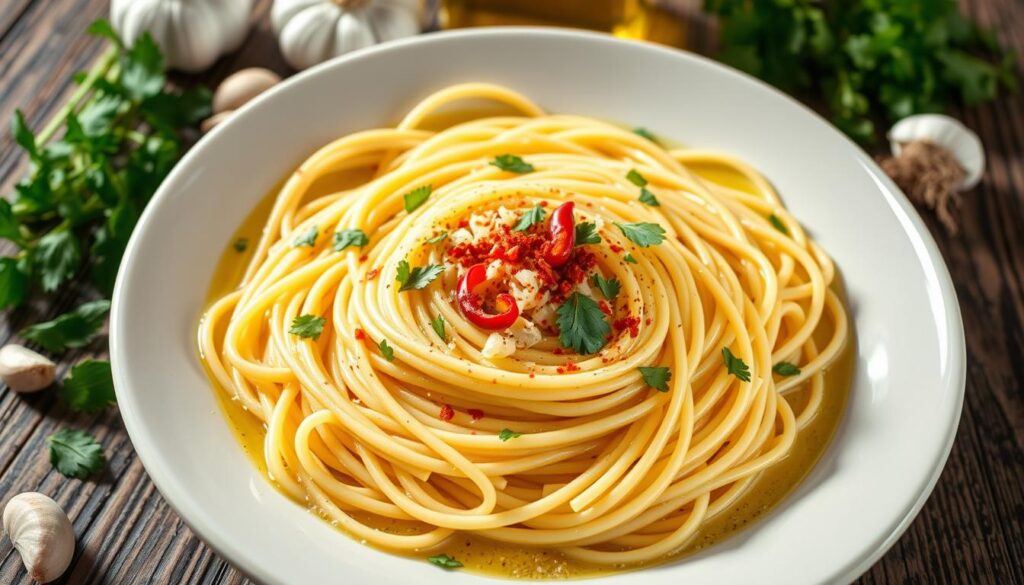
Key Takeaways
- Spaghetti Aglio e Olio is a classic Italian pasta dish with a rich history and cultural significance.
- The recipe features a simple yet flavorful combination of spaghetti, garlic, and olive oil.
- This dish is known for its authenticity, ease of preparation, and versatility in Italian cuisine.
- Spaghetti Aglio e Olio is a beloved staple that showcases the elegance of traditional Italian cooking.
- With its delicious taste and straightforward instructions, this recipe is a must-try for pasta lovers.
The History and Origins of Spaghetti Aglio e Olio
Spaghetti Aglio e Olio is a classic Italian dish from Naples. It has a long history, evolving with Neapolitan cuisine. Now, it’s loved in kitchens all over Italy and the world.
Traditional Neapolitan Roots
The dish started in Naples’ busy streets. Italian cooks there made it simple yet tasty. It shows how Neapolitan cooks used local ingredients.
Evolution Through Italian Cuisine
As Italian cuisine grew famous, Spaghetti Aglio e Olio changed. Chefs added their own twists, making it even better.
Cultural Significance in Modern Cooking
Now, Spaghetti Aglio e Olio is a key part of Italian food. It shows the beauty of Italian cooking. This dish has become a favorite around the world.
“Spaghetti Aglio e Olio is a testament to the power of simplicity in Italian cuisine. Its enduring popularity is a testament to the timeless appeal of authentic, well-executed dishes.”
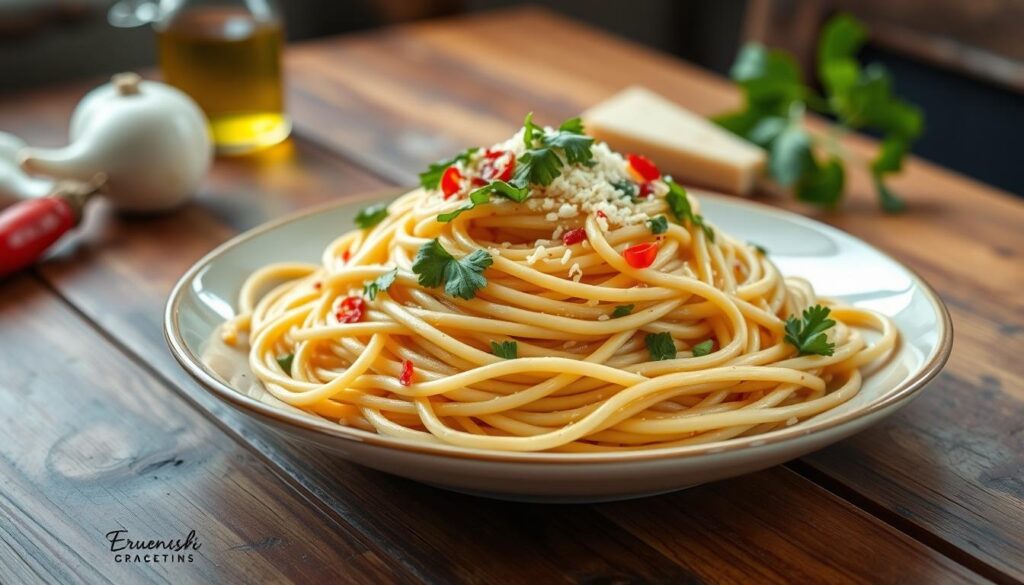
Essential Ingredients for the Perfect Aglio e Olio
To make a true garlic pasta recipe like Spaghetti Aglio e Olio, you need the right ingredients. This flavorful pasta dish is all about a few key things. They come together to give you a taste you won’t forget.
The base of Spaghetti Aglio e Olio is extra-virgin olive oil. Choose a strong, full-bodied olive oil for its rich taste and a hint of pepper. Next, you need fresh, aromatic garlic. It gives the pasta its unique smell and zesty taste.
- High-quality extra-virgin olive oil
- Fresh, whole garlic cloves
- Spaghetti or other long pasta noodles
- Salt and freshly ground black pepper to taste
Even though the list of ingredients is short, each one is crucial. Using the best olive oil and garlic makes your garlic pasta recipe truly special. It highlights the natural tastes of Italian cooking.

“The secret to a great Aglio e Olio is in the quality of the ingredients. Use the best olive oil and freshest garlic for maximum flavor.”
Kitchen Tools and Equipment Needed
To make the perfect Spaghetti Aglio e Olio, you need the right tools. From must-have cookware to nice-to-have utensils, we’ll cover what you need. This will help you improve your Italian cooking skills.
Essential Cookware
- A large pot or Dutch oven for boiling the pasta
- A skillet or saucepan for sautéing the garlic and oil
- A wooden spoon or tongs for stirring and serving the pasta
- A colander for draining the cooked pasta
Optional Utensils for Enhanced Preparation
While you must have the basic cookware, some optional tools can help a lot. They make preparing Spaghetti Aglio e Olio easier:
- A garlic press or mincer for finely chopping the garlic
- A Microplane or zester for grating Parmesan cheese
- A chef’s knife or santoku knife for slicing ingredients
- A cutting board for prepping your ingredients
Storage Containers
It’s key to keep leftover Spaghetti Aglio e Olio fresh. Use airtight glass or plastic containers for refrigerating extra portions.
| Essential Pasta Cooking Tools | Recommended Additional Utensils |
|---|---|
| Large pot, skillet, colander, wooden spoon | Garlic press, Microplane, chef’s knife, cutting board |
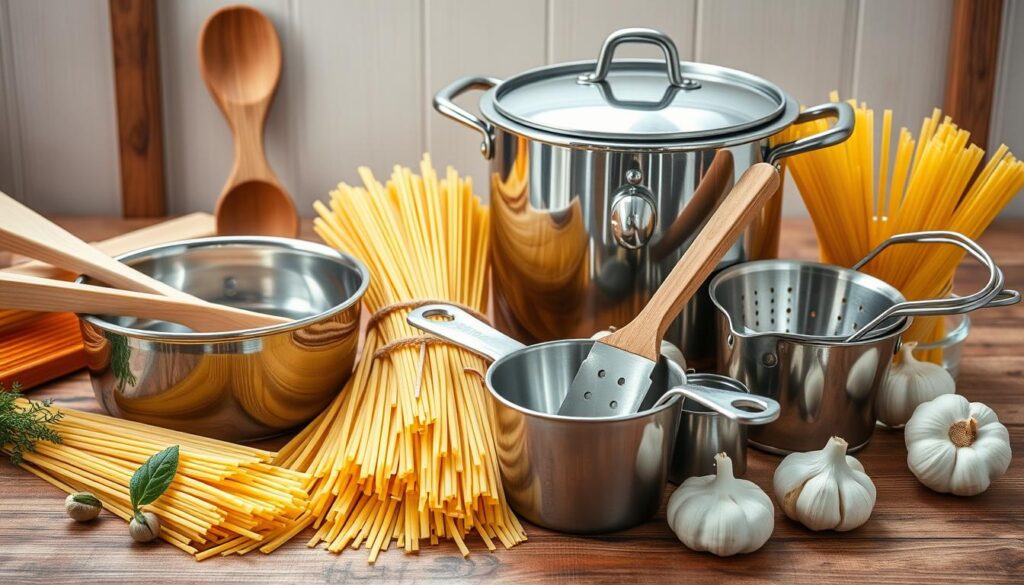
With these pasta cooking tools and kitchen essentials for Italian cooking, you’re ready to make a tasty Spaghetti Aglio e Olio dish.
Step-by-Step Guide: Delicious and Easy Spaghetti Aglio e Olio Recipe
Spaghetti Aglio e Olio is a classic Italian dish loved for its simplicity and bold flavors. It’s great for a quick weeknight dinner or a vegetarian pasta meal. Follow these easy steps to make a tasty Spaghetti Aglio e Olio in no time.
- Bring a large pot of salted water to a boil. Add the spaghetti and cook until it’s al dente, as the package says.
- While the pasta cooks, heat a large skillet over medium-low heat. Add olive oil and thinly sliced garlic cloves. Cook the garlic, stirring now and then, until it’s fragrant and lightly golden, about 2-3 minutes. Watch it closely to avoid burning the garlic.
- Once the pasta is done, drain it, saving a cup of the starchy cooking water.
- Add the drained spaghetti to the skillet with the garlic-infused oil. Toss the pasta to coat it evenly with the oil. Add a splash of the reserved cooking water if needed to make a light, glossy sauce.
- Season the pasta with salt and freshly ground black pepper to taste. For extra flavor, stir in a handful of fresh parsley or basil leaves.
Serve the Spaghetti Aglio e Olio right away, garnished with more parsley or basil if you like. Enjoy this easy spaghetti recipe as a quick weeknight dinner or a satisfying vegetarian pasta meal.
Tips for Perfectly Cooked Al Dente Pasta
Getting the perfect al dente texture is key for classic Italian dishes like Spaghetti Aglio e Olio. Follow these expert tips to improve your pasta cooking. This way, your noodles will be cooked just right every time.
Water to Pasta Ratio
The right water-to-pasta ratio is essential for al dente texture. Use 4-6 quarts of water for every 1 pound of dry pasta. This amount lets the pasta cook evenly, avoiding stickiness.
Salt and Timing Techniques
Salting the pasta water is crucial. It seasons the noodles and helps keep them al dente. Add 1-2 tablespoons of salt before adding the pasta. Also, cook the pasta 1-2 minutes less than the package suggests for the perfect bite.
Testing for Doneness
The best way to check if pasta is al dente is to taste it. Start checking a few minutes before the recommended time. Look for a slight resistance and a tender yet firm center. If it’s too firm, keep cooking and checking until it’s right.
By following these tips, you’ll master the art of cooking al dente pasta. Serve it with the Spaghetti Aglio e Olio recipe for a true Italian meal.
Enhancing Your Dish with Optional Ingredients
The classic Spaghetti Aglio e Olio recipe is already a hit. But, you can make it even better by adding Italian flavor variations. A few extra ingredients can take this dish from simple to spectacular.
Adding red pepper flakes is a great choice. They bring a spicy kick that matches the garlic and olive oil perfectly. If you prefer something milder, try fresh herbs like parsley, basil, or oregano. They add a fresh, green flavor.
For a richer taste, try adding grated cheese like Parmesan or Pecorino Romano. These cheeses bring a salty, savory flavor that makes the dish more indulgent.
| Optional Ingredient | Flavor Profile | Recommended Amount |
|---|---|---|
| Red Pepper Flakes | Spicy, heat | 1/4 to 1 teaspoon |
| Fresh Herbs (Parsley, Basil, Oregano) | Aromatic, herbal | 2-3 tablespoons, chopped |
| Grated Cheese (Parmesan, Pecorino Romano) | Salty, savory | 2-4 tablespoons |
Spaghetti Aglio e Olio is all about simplicity. But, with these optional ingredients, you can explore a world of customizing pasta dishes. It shows how versatile this classic dish can be.
“The key to a great Aglio e Olio is finding the right balance between the simple, pure flavors of the garlic, olive oil, and pasta. The optional ingredients are like musical notes that can elevate the entire composition.”
Common Mistakes to Avoid When Making Aglio e Olio
Making Spaghetti Aglio e Olio seems easy, but there are common mistakes. These can ruin your dish. To master this pasta cooking classic, watch out for these errors. This way, you’ll get the best perfecting Italian recipes.
Temperature Control Issues
Getting the right temperature is key for Aglio e Olio. If the oil is too cold, the garlic won’t sizzle. This means it won’t add the dish’s special smell.
On the other hand, too hot oil can burn the garlic. This makes the dish taste bitter and bad.
Ingredient Proportions
- The right mix of garlic and olive oil is essential. Too much garlic can overpower the dish. Too little, and it won’t taste good.
- The pasta to sauce ratio is also important. Too much pasta makes the dish dry. Too little, and it’s too oily.
Timing Mistakes
- Don’t overcook the pasta. It should be al dente, not mushy. Watch the cooking time closely.
- Don’t let the garlic cook too long. It can turn bitter. Take it off the heat when it’s just right.
Knowing these common pasta cooking mistakes helps you make perfect Spaghetti Aglio e Olio. With practice and attention to detail, you’ll soon be perfecting Italian recipes.
Serving Suggestions and Wine Pairings
Spaghetti Aglio e Olio is a classic Italian dish that can be served in many ways. It’s simple yet flavorful, making it a joy to eat. Choosing the right wine to pair with it can enhance the experience even more.
Pasta Serving Ideas
- Serve the spaghetti Aglio e Olio in a wide, shallow bowl to showcase the delicate olive oil-based sauce.
- Garnish the pasta with freshly chopped parsley, a drizzle of high-quality olive oil, and a sprinkle of grated Parmesan cheese for a visually appealing presentation.
- Consider serving the spaghetti alongside grilled or roasted vegetables, such as asparagus, broccoli, or zucchini, for a balanced and nutritious meal.
Suggested Italian Wine Pairings
Spaghetti Aglio e Olio pairs well with several Italian wine pairings. Here are some great options:
| Wine Varietal | Tasting Notes | Why it Works |
|---|---|---|
| Pinot Grigio | Crisp, light, and refreshing with subtle citrus and mineral notes | The acidity in Pinot Grigio helps to cut through the richness of the olive oil-based sauce, creating a harmonious balance. |
| Verdicchio | Bright, clean, and often with hints of green apple and almond | The fresh, clean profile of Verdicchio complements the garlic and herb flavors in the Aglio e Olio dish. |
| Chianti | Medium-bodied with notes of red fruit, leather, and spice | The slight bitterness and acidity in Chianti provides a nice contrast to the subtle flavors of the pasta. |
Whether you serve Spaghetti Aglio e Olio in a fancy way or keep it simple, the key is to enjoy its flavors. With the right pasta serving ideas and Italian wine pairings, this dish is sure to please your taste buds.
Storing and Reheating Leftover Aglio e Olio
Spaghetti Aglio e Olio is a tasty and simple Italian dish. But what do you do with leftovers? Using the right pasta storage tips and reheating methods can make your leftovers just as good as the first time.
Storing Leftover Aglio e Olio
To keep your leftover pasta dishes fresh, follow these easy steps:
- Let the pasta cool down completely before putting it in an airtight container.
- Make sure the container is dry to avoid mold.
- Keep the leftover Aglio e Olio in the fridge for 3-4 days.
- If you want to store it longer, freeze it in an airtight container or bag for 2-3 months.
Reheating Aglio e Olio
Ready to enjoy your leftover pasta dishes? Here are a few ways to keep the flavor and texture right:
- On the stovetop: Heat a bit of olive oil in a pan over medium heat. Add the leftover Aglio e Olio and stir gently until it’s warm.
- In the microwave: Put the pasta in a microwave-safe dish with a little water or olive oil. Heat in 30-second bursts, stirring each time, until it’s hot.
- In the oven: Preheat to 350°F (175°C). Put the pasta in an oven-safe dish, add some olive oil, and bake for 10-15 minutes.
By using these pasta storage tips and reheating methods, your leftover Spaghetti Aglio e Olio will taste just as good as the first time. Enjoy this classic Italian dish again and again.
Conclusion
Spaghetti Aglio e Olio is a true gem in the world of easy Italian recipes. It’s not only simple to make but also packed with authentic Italian flavors. These flavors take you straight to Italy’s heart.
This classic pasta dish has a rich history and is loved worldwide. It started in Naples and has become a favorite globally. With just a few ingredients and simple steps, you can make it at home. It will boost your cooking skills and satisfy your taste buds.
So, why wait? Dive into the world of Spaghetti Aglio e Olio and explore the flavors of Italian cuisine. It’s perfect for both experienced cooks and beginners. This recipe will quickly become a favorite in your kitchen. Buon appetito!
FAQ
What is Spaghetti Aglio e Olio?
Spaghetti Aglio e Olio is a tasty Italian pasta dish. It’s made with spaghetti tossed in a garlic and olive oil sauce.
What are the key ingredients in Spaghetti Aglio e Olio?
The main ingredients are olive oil, fresh garlic, and spaghetti. Some recipes add red pepper flakes, parsley, and Parmesan cheese.
How long does it take to make Spaghetti Aglio e Olio?
It’s a quick dish, ready in under 30 minutes. It’s perfect for a weeknight dinner.
Is Spaghetti Aglio e Olio a vegetarian dish?
Yes, it’s vegetarian. It doesn’t have meat or animal products, except for Parmesan cheese.
What type of pasta is traditionally used for Spaghetti Aglio e Olio?
Traditionally, it’s made with spaghetti. But you can also use linguine or bucatini if you like.
How can I achieve the perfect al dente texture for the pasta?
Use the right water-to-pasta ratio and salt the water. Taste the pasta to check if it’s done before draining.
Can I customize Spaghetti Aglio e Olio with additional ingredients?
Yes, you can add red pepper flakes, herbs, or Parmesan cheese. It lets you make it your own.
How should I store and reheat leftover Spaghetti Aglio e Olio?
Store it in an airtight container in the fridge for 3-4 days. Reheat with a bit of olive oil or water to keep it moist.



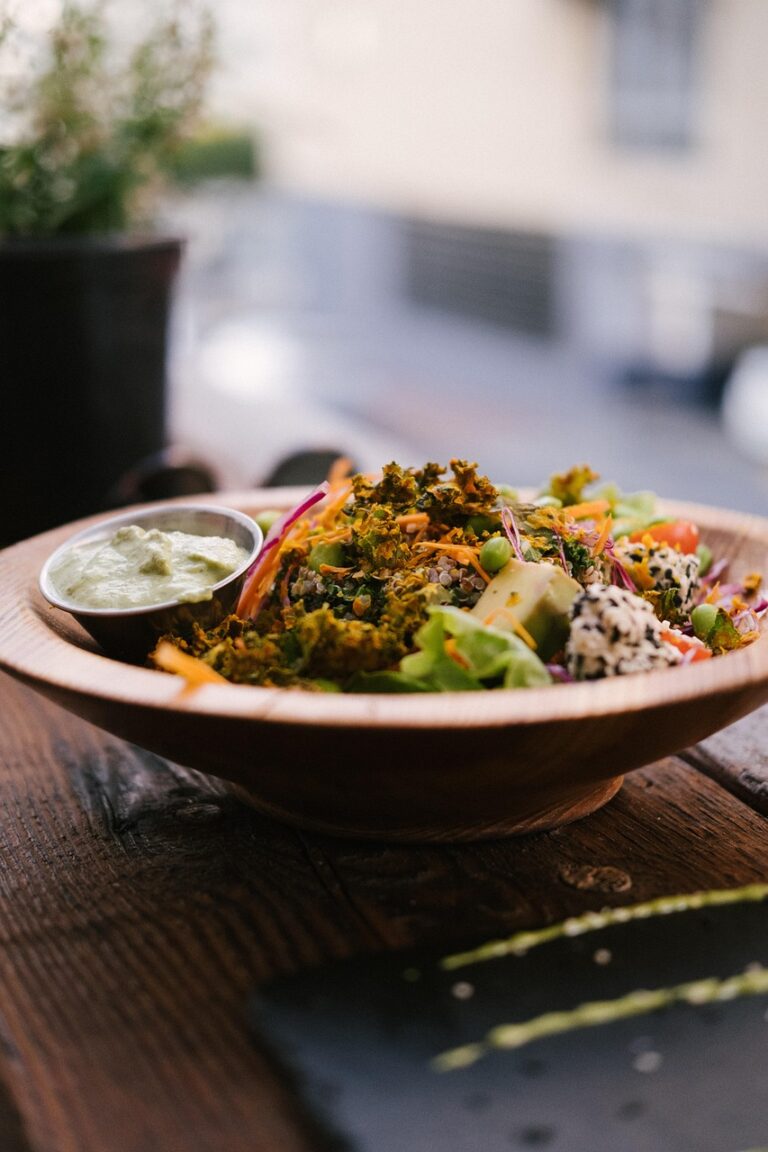
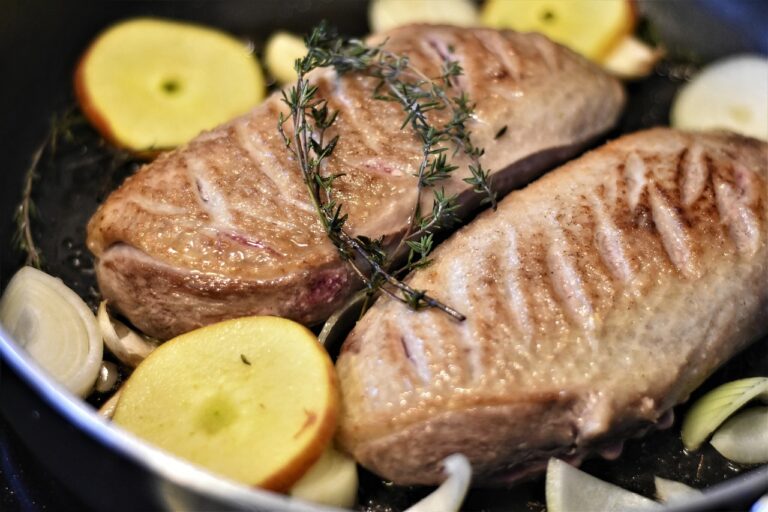
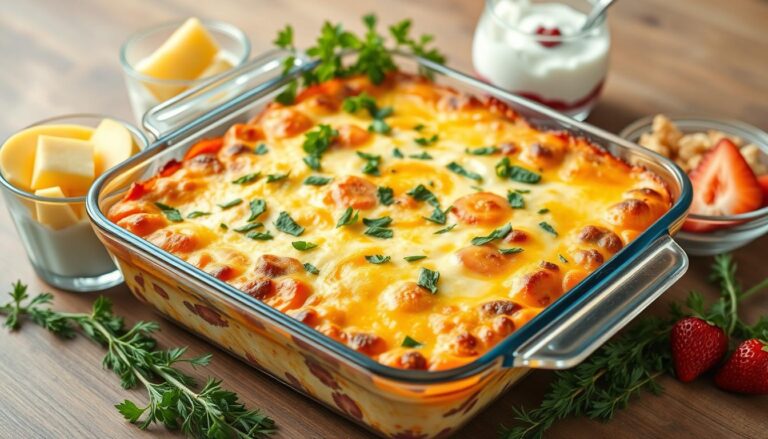
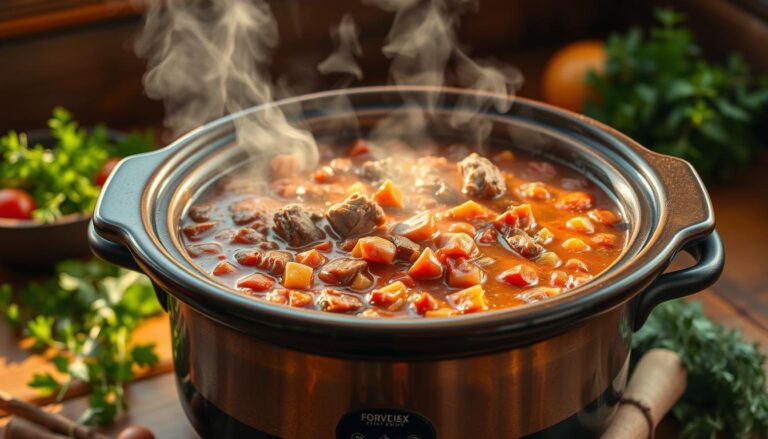

One Comment